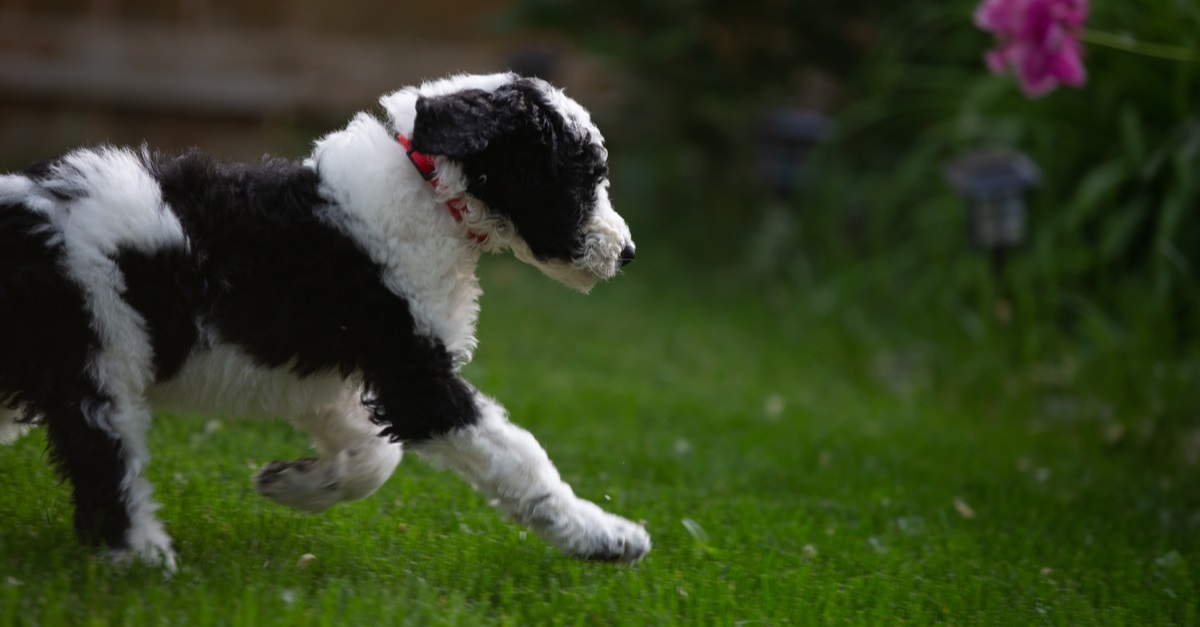Sheepadoodle vs Bernedoodle: Dog Breed Comparison
When you search for the ideal family dog or household pet, you’ll find many great breeds to choose from, such as the Mini Goldendoodle, Golden Retriever, Australian Shepherd, Old English Sheepdog, and the Bernese Mountain Dog.
Plenty of great dog breeds make an excellent family dog, including hybrid breeds that combine the Miniature or Standard Poodle with another family-friendly breed.
The Sheepadoodle and Bernedoodle dog breeds make great family dogs, and they are both intelligent hybrid doodle breeds. While both designer breeds are loyal, playful, and easy to train, each dog features several differences worth considering when choosing a puppy to adopt for home.
Bernedoodles
A Bernedoodle puppy is a designer breed that combines a Standard Poodle and Bernese Mountain Dog. While these beautiful dogs aren’t bred for competitive sports and activities, they make ideal family companions.
They socialize and play well with children, are hard-working, and can handle colder climates outdoors, much like their parent breed, the Bernese Mountain Dog, which originated from Switzerland.
Sheepadoodles
Sheepadoodles became popular in the 1980s, offering all the wonderful personality traits of their parent breeds, a cross between an Old English Sheepdog and a poodle. Old English Sheepdogs are known for their shaggy fur and ability to herd animals such as cattle, sheep, or working dogs. They are protective and have a good-natured temperament.
Physical Features of Bernedoodles vs Sheepadoodles
Bernedoodles and Sheepadoodles share similar characteristics, such as small to medium-size, good health, and a similar lifespan. Each designer dog breed has a curly, fluffy fur coat with various colors and styles. Bernedoodles vary in weight from 60 to 90 pounds, which depends on their parent breeds, and have a height that generally ranges between 24 and 29 inches.
Sheepadoodles are slightly larger and typically weigh between 50 and 80 pounds, with a more diminutive stature and height of about 20 to 27 inches. Both designer dog breeds vary in size and height based on the Poodle parent’s specific breed and size.
Coat Texture and Color
Bernedoodles have vibrant curly coat colors, often in a tri-color blend of various brown, white, gray, dark red, and black combinations. The fur length varies considerably based on the poodle parent breed, though most dogs have long, thick, wavy or curly coats.
Sheepadoodles, on the other hand, have softer, curlier fur that’s typically just two colors, and these colors are typically a mix of white, black, gray, or red. Both dog breeds have wavy or curly fur and don’t shed much, which is ideal for dog owners with allergies.

Grooming Requirements for Bernedoodles and Sheepadoodles
Bernedoodles and Sheepadoodles have a similar curly, wavy coat type that is medium to long. While they don’t shed much, they require regular grooming to maintain their coat and prevent skin conditions and infections.
Regular coat care will also help prevent matting and helps natural oils nourish the skin, which is ideal for overall coat and skin health.
Behavior and Temperament
Both Bernedoodles and Sheepadoodles are friendly, playful, and entertaining dogs. Whether you adopt a Miniature Bernedoodle or Standard Sheepadoodle, you’ll find both breeds make lovely family pets. There are some notable differences to consider when choosing between a Sheepadoodle or a Bernadoodle puppy.
Sheepadoodles are playful, energetic, and enjoy socializing with humans and other dogs. They make ideal emotional support animals and are alert to picking up on changes in human emotions or detecting if there is an intruder or danger present.
Sheepadoodles have a protective nature that’s perfect for children and individuals who benefit from therapy or emotional support animals.
Bernedoodles are friendly and playful, much like Sheepadoodles, though they tend to be calmer and gentle. Their energy levels tend to be more moderate, and while they enjoy interacting with humans and love to socialize, they are sensitive and may get frightened easily in unfamiliar situations.
While Sheepadoodles are more alert to unusual sounds or situations, Bernedoodles shy away from them, a distinct difference between the two breeds.
Health and Life Expectancy
When you adopt a designer or hybrid breed, they generally have excellent or above-average health. Unlike purebred dogs and pets, crossbreeding reduces some of the hereditary traits common in many dogs, such as hip dysplasia, cataracts, and skin allergies.
Sheepadoodles and Bernedoodles have a similar lifespan of between 12 and 18 years, with Bernedoodles likely to live a bit closer to 18 years than Sheepadoodles.
While both hybrid dog breeds are likely to enjoy good health, it’s important to schedule regular appointments with a veterinarian to detect health conditions and illnesses early due to crossbreeding. An early diagnosis is the best option for successful treatment, which can help prevent further issues and improve your pet’s health and life expectancy.
Training Bernedoodles vs Sheepadoodles
Bernedoodles and Sheepadoodles are receptive to training and are generally hard-working, intelligent, and obedient. They thrive on exploring new places, sounds, and people, which makes it essential to train them as a puppy and gives them the physical and mental stimulation needed as they develop.
Bernedoodles love to interact with humans and aim to please their owners. They learn best with reward-based training and require continuous care to ensure they don’t get too rowdy or unruly. You may need to try several training strategies to find the proper method for taming your Bernedoodle, though overall, they are receptive and respond well to encouragement.
Sheepadoodles are quick learners and tend to get bored fast. While they are great at remembering tasks and adapting to new situations, they need constant stimulation, which can sometimes be challenging.
Despite the differences between the two dog breeds, both Bernedoodles and Sheepadoodles are easy to train, especially with socializing and rewards as incentives.

Tips for Adopting a Bernedoodles vs Sheepadoodles
Adopting a Bernedoodle or Sheepadoodle puppy is a rewarding experience, and you’ll want to make sure that the breed you choose best fits your home and lifestyle. While each crossbreed poodle mix offers similar characteristics, it’s essential to take several steps when choosing a puppy to adopt:
- Get familiar with the parent breeds, and find details such if the breed size is a miniature poodle, toy poodle, or standard poodle, and the health history of both parents
- Inquire about diet, potential health concerns, and other details that will support your new puppy
- Only adopt your puppy from a reputable breeder
Summary
Sheepadoodles and Bernedoodles make fantastic family dogs and are often adopted as therapy dogs or emotional support animals. Both are healthy dog breeds and socialize well with families and kids, similar to a Border Collie, Australian Shepherd, or Saint Berdoodle. They are playful, affectionate, and easy to train, making both hybrid breeds ideal for most living spaces and great pets.